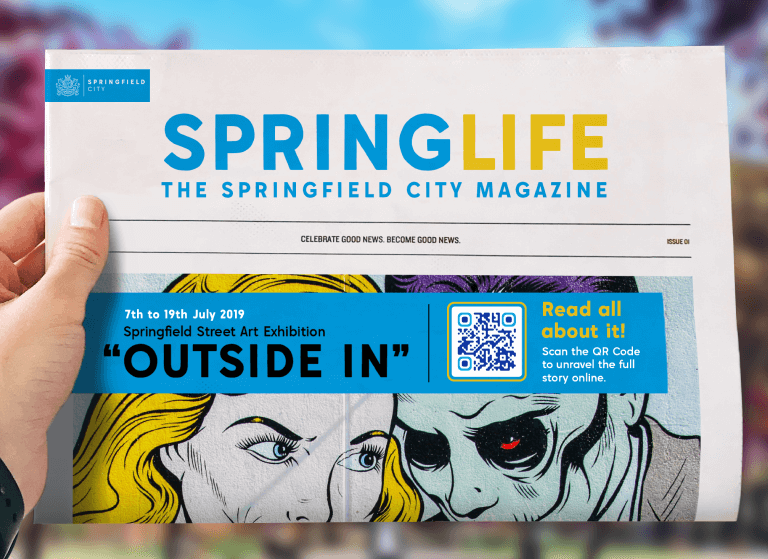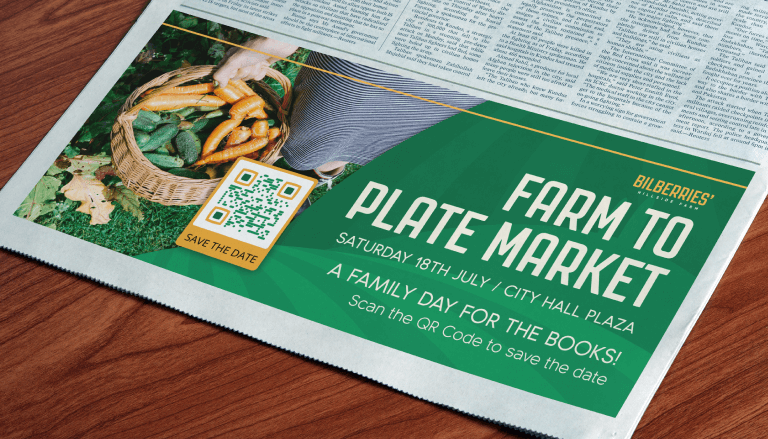- Best Practices ●
- COVID-19 ●
- Industry Trends ●
- Partners ●
- Product ●
Are QR Code News Articles the Future of Newspapers in the Digital Age?
It’s hard to think of the newspaper industry without immediately wondering whether print media will survive the digital age. From TEDx Talks to special reports on late-night TV shows, the approaches to the future of news have been discussed and dissected repeatedly. The rise of cyber-media spaces led to the concern that digitalism would bring with it the death of journalism; or to be more precise, the ethics of journalism, truth, accuracy, and objectivity, would see a downfall. Replaced, instead, by click-based news that focuses more on what readers want versus the need to inform.
In the last few years, more and more news outlets have migrated their content to digital platforms. Yet, a few small and young news presses like Stadt40 News based in Münster, Germany, have found that in the debate of either print or online, perhaps the answer is “why not both.” Starting out as an online news source, they designed and printed a quarterly newspaper using headlines, pictures, and a URL QR Code for each story that leads to the full article online—in essence, bringing to life a literal bridge between print and digital.
This raises the question of this blog: can QR Code news articles be the future of newspaper? And can QR Code solutions bring innovative dimensions to a static media outlet?
-
Table of contents
- What are QR Code news articles?
- The boom of big media and the newspaper in crisis
- 5 advantages of using QR Code news articles
- #1 Saves on paper and printing costs
- #2 Instant access to information
- #3 The latest story is just one scan away
- #4 Solidifying brand identity
- #5 Target more demographics
- How to use QR Code news articles to build stronger credibility
- The Video QR Code
- The MP3 QR Code
- The Social Media QR Code
- Final thoughts
What are QR Code news articles?
QR Code news articles are newspapers that print the headline and accompanying picture of stories on physical editions but use QR Code technology to link to the full-length article on a digital platform instead of printing them in their entirety on paper.
Newspaper and Magazine QR Codes present publications, both big and small, with new opportunities to simultaneously reach a wider audience through online channels while still catering to local demographics with physical editions.
The boom of big media and the newspaper in crisis
Movies like the 2005 historical drama Good Night and Good Luck and the 2015 film Spotlight, though differing in media outlets, feature journalism at its peak: news teams uncovering the objective facts of a story and bringing them to light for the public.
Newspapers had their days of glory during the U.S. global media revolution of the 1980s, as did other media giants. The media consolidation, essentially a sweep of mergers and acquisitions within the newspaper industry, truly took flight in 1985.
And though it brought with it massive benefits in the form of higher revenue for the industry, the continued desire for more growth and corporate consolidations with businesses that at times had nothing to do with journalism took its toll.
For years, journalists had fought to retain their independence to engage in better ethical reporting: accurate, objective truth for the public. However, the creation of these media conglomerates meant crashing into a wall. The wall? Conflict of interests.
But it went beyond actual cases of conflicting gains. If a newspaper fell under the same corporate umbrella as another company, how could the public trust that the stories from said newspaper covering any issues from this business would be unbiased?
At the end of the century, traditional news communication channels, including newspapers, saw a drop in stock prices. Slowly but surely, these media platforms were being replaced by the growing influence of the world wide web. Following 9/11, traditional news media saw a surge in sales and public attention before being knocked back down by the small recession that came a bit after.
Newspapers, with their fixed costs (payroll, pensions, debts, and health insurance for full-time workers to name a few), needed a steady income from sales that were simply declining year after year.
With the advent of new sites that catered to the specific needs of audiences, the public was less and less inclined to keep their subscriptions alive or purchase the paper daily.
The static nature of the journal stood in stark contrast to the vivacity of the internet. While newspapers report, internet sites dive deep into issues and provide forums and comment sections that keep the discussion on topics like politics, sports, business, or the arts alive and up to date.
Though digital spaces have created problems of their own, notably the echo chambers people curate for themselves by only following online platforms that align with their point of view, the speed and cost-free nature of the web continue to be more alluring.
This means the newspaper industry has slowly shifted to the digital, at times abandoning its traditional print form altogether.
5 advantages of using QR Code news articles
Of course, many will argue that there is something tangible about holding a physical piece of literature, whether a book or newspaper. But it’s difficult to overlook the growing tendency of the last decade for audiences to want to be met online.
That doesn’t mean that it’s an either-or equation, as Stadt40 News has recently demonstrated. Funded by local advertisers, the Münster-based news outlet releases three times a year a free, print version of their equally free-of-charge online channel: The QR Code Zeitung (QR Code journal or newspaper).
The layout looks exactly like that of a traditional newspaper with a single exception: the full-length articles have been replaced by QR Codes that act as digital news portals to the full, online versions.
Laura, from the Stadt40 News team, explained that by “establishing a partnership between online and offline, we are giving readers access to printed information as well as immediate access to web info.”
Laura highlighted that the idea behind the inception of the QR Code Zeitung with its QR Code news articles came from the strong belief that to be informed in all matters was a basic right for all demographics and that it should be accessible and free for all. This has been a benefit they were able to provide, and they listed five key advantages of implementing QR Code news articles.
#1 Saves on paper and printing costs
First and foremost, using a QR Code based-newspaper layout has saved them on printing costs. Not only that, since the QR Code format uses a smaller amount of space than blocks of text, they were able to minimize their paper usage and create a more compact newspaper: one A1 broadsheet and an A2 sheet that amounts to a six-page newspaper.
That means they cover a wide range of topics, from international politics to local cultural events, while keeping the printed material at a much more manageable size for a coffee table or a quick read.

#2 Instant access to information
Not only do they use QR Codes for news articles, but Laura explained that the logo of their printed paper is also a QR Code. This one leads scanners to their homepage, where they can find a menu bar at the top of the landing page with all the different sectors covered, as well as a full list of up-to-date stories.
This minimizes the search time and cuts through the noise of the internet. Readers, Stadt40 News explained, “no longer need to google us and search for the right link. With a simple scan of their phone, they can access our website instantly without the fuss of typing.”
#3 The latest story is just one scan away
In response to the static nature of the newspaper, unchanging and uneditable once printed, the Dynamic QR Code brings a new layer to the QR Code on paper: fresh off the presses information, any time, and breathes new life into this traditional format.
If readers want to follow up on any updates from a headline in the newspaper, they can do so by scanning an assigned QR Code and checking out the latest scoop on their online platform.
#4 Solidifying brand identity
Saving on print and paper is not the only advantage brought over by QR Code magic. A minimalistic approach on one end has allowed Stadt40 News to reinforce its brand with a colorful design.
Blue and white are the newspaper’s colors, and they can broadly flaunt them through their customized QR Codes. But, they have also integrated aspects of the Code into the design of the pages.
An actual, functional QR Code is their logo (as we mentioned before) but they have also added an abstract version of a QR Code as both their official logo as well as within the background of the paper. Readers can see a constellation of pixels strategically scattered throughout the pages.
In addition, they can print the logos of local advertisers in their full colors.
#5 Target more demographics
This tangible representation of the futuristic fairytale of traditional news means that they can meet digital demands while engaging with local communities.
The QR Code as a custom newspaper maker allows journalism to expand online without chipping away at journalistic responsibilities, meaning the industry can target a more global audience through their digital channels and reach readers in the physical world with their printed copies.
This is the literal definition of the QR Code: a bridge between online and offline.

How to use QR Code news articles to build stronger credibility
Giving readers access to a printed information source while simultaneously offering a digital news portal to online resources is what the QR Code is all about. But with Dynamic QR Codes, so much more can be offered to their world of printed news media.
Here, we are looking beyond bridging the gap between traditional and digital and focusing on ways to elevate physical editions using a few different QR Code solutions to create stories that are moving, yes, but also informative and credible.
The Video QR Code
Have an interview in video format? Want to report on a political speech? Wish you could, word for word, describe the atmosphere that reigned over a stadium as the favored team scored the winning point? Then simply link directly to actual, visual footage with the Video QR Code. You can connect readers to one video or an entire playlist.
The news comes in various forms, and one of those has been the video broadcast. The QR Code not only links from digital to physical, but it also allows materials to link from one online platform to another and to create enriching printed stories that extend beyond pictures.
The MP3 QR Code
Chances are, you or another group of people have curated content online dedicated to a specific topic and turned it into a podcast. With the MP3 QR Code, you can link your story to your specific audio file, allowing readers to delve deeper into their chosen topic.
Or maybe you are covering a musical or theatrical release on a local stage. You can use the MP3 QR Code to really color the pages with the sounds that are sometimes hard to capture with words.
The Social Media QR Code
Journalists go beyond the story: they look beyond the facts and dig to uncover greater details for the general public to get a full picture and understanding of a report.
Perhaps the Social Media QR Code is the perfect tool to provide readers with a platform to follow a journalist on their journey, and a microsite for writers to list all the channels they are available on or resources they used while uncovering a story.
Final thoughts
The future of news and traditional media has faced unprecedented challenges with the birth of the internet. Faster technologies stole print’s thunder, and as far as anyone was concerned, the printed newspaper was taking its final breaths before the long sleep along ancient tablets and scrolls. Its long-range prospects were grim.
Surprisingly, an unforeseen ally arose from the ranks of what was thought to be the enemy. QR Code technology heralded endless possibilities of a QR magazine, QR Code newsletters, and QR Code news articles. In essence, morphing into QR News. A partnership that has racked up an astonishing set of advantages, from saving on costs to reaching a wider demographic and potentially providing free access to noteworthy journalism.
What QR Code for news can do is provide access to a global catalog that does not pander to clickbait—and doesn’t burn out its writers by demanding hollow word counts and mass creation of content for the sake of the algorithm. QR Code news articles are the potential model to adapt newspapers to the ever-changing media landscape.
And beyond that, with Dynamic QR Codes like the video or app Code, the immutable that was once the paper can now transform into fluid information building and sharing. The future of newspaper in the digital age indeed.





 Add custom colors, logos and frames.
Add custom colors, logos and frames.
